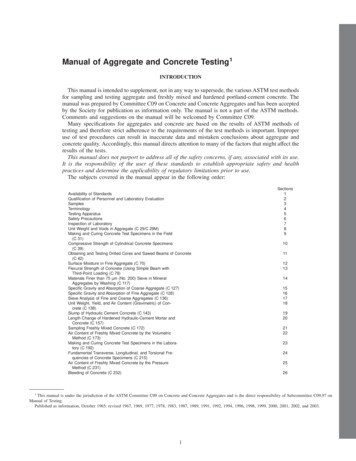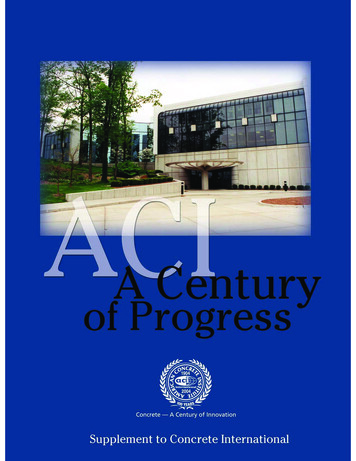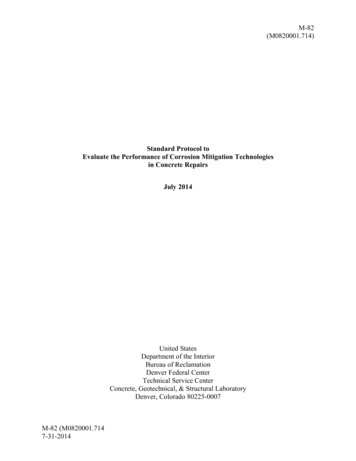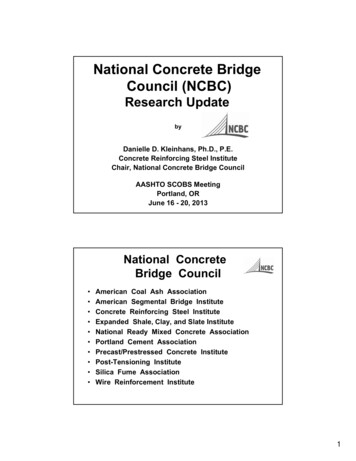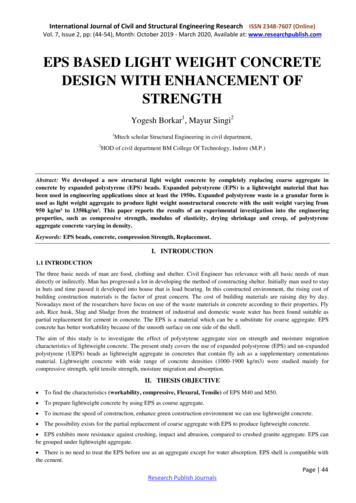
Transcription
International Journal of Civil and Structural Engineering Research ISSN 2348-7607 (Online)Vol. 7, Issue 2, pp: (44-54), Month: October 2019 - March 2020, Available at: www.researchpublish.comEPS BASED LIGHT WEIGHT CONCRETEDESIGN WITH ENHANCEMENT OFSTRENGTHYogesh Borkar1, Mayur Singi21Mtech scholar Structural Engineering in civil department,2HOD of civil department BM College Of Technology, Indore (M.P.)Abstract: We developed a new structural light weight concrete by completely replacing coarse aggregate inconcrete by expanded polystyrene (EPS) beads. Expanded polystyrene (EPS) is a lightweight material that hasbeen used in engineering applications since at least the 1950s. Expanded polystyrene waste in a granular form isused as light weight aggregate to produce light weight nonstructural concrete with the unit weight varying from950 kg/m³ to 1350kg/m³. This paper reports the results of an experimental investigation into the engineeringproperties, such as compressive strength, modulus of elasticity, drying shrinkage and creep, of polystyreneaggregate concrete varying in density.Keywords: EPS beads, concrete, compression Strength, Replacement.I. INTRODUCTION1.1 INTRODUCTIONThe three basic needs of man are food, clothing and shelter. Civil Engineer has relevance with all basic needs of mandirectly or indirectly. Man has progressed a lot in developing the method of constructing shelter. Initially man used to stayin huts and time passed it developed into house that is load bearing. In this constructed environment, the rising cost ofbuilding construction materials is the factor of great concern. The cost of building materials are raising day by day.Nowadays most of the researchers have focus on use of the waste materials in concrete according to their properties. Flyash, Rice husk, Slag and Sludge from the treatment of industrial and domestic waste water has been found suitable aspartial replacement for cement in concrete. The EPS is a material which can be a substitute for coarse aggregate. EPSconcrete has better workability because of the smooth surface on one side of the shell.The aim of this study is to investigate the effect of polystyrene aggregate size on strength and moisture migrationcharacteristics of lightweight concrete. The present study covers the use of expanded polystyrene (EPS) and un-expandedpolystyrene (UEPS) beads as lightweight aggregate in concretes that contain fly ash as a supplementary cementationsmaterial. Lightweight concrete with wide range of concrete densities (1000-1900 kg/m3) were studied mainly forcompressive strength, split tensile strength, moisture migration and absorption.II. THESIS OBJECTIVE To find the characteristics (workability, compressive, Flexural, Tensile) of EPS M40 and M50. To prepare lightweight concrete by using EPS as course aggregate. To increase the speed of construction, enhance green construction environment we can use lightweight concrete. The possibility exists for the partial replacement of coarse aggregate with EPS to produce lightweight concrete. EPS exhibits more resistance against crushing, impact and abrasion, compared to crushed granite aggregate. EPS canbe grouped under lightweight aggregate. There is no need to treat the EPS before use as an aggregate except for water absorption. EPS shell is compatible withthe cement.Page 44Research Publish Journals
International Journal of Civil and Structural Engineering Research ISSN 2348-7607 (Online)Vol. 7, Issue 2, pp: (44-54), Month: October 2019 - March 2020, Available at: www.researchpublish.comIII. CRITIQUE SURVEYED A survey of journal articles published between 2010 and 2019 yields studies that vary in scope and level of analysis,yet with consistently good results. As our aim is to develop concrete which does not only concern on the strength of concrete, it also having many otheraspects to be satisfied like workability, performance, durability and also economy. So for this we need to go for theaddition of pozzolanic materials along with super plasticizer with having low water cement ratio. The use of silica fume ismany, which is having good pozzolanic activity and is a good material for the production high performance concrete. Theapplication of silica fume in concrete mixture has significantly increased and enhanced the properties of the concretewhether it is in wet stage or in harden condition. Also now a day’s one of the great applications in various structural fieldsis fiber reinforced concrete, which is getting popularity because of its positive effect on various properties of concrete.1. The Mechanical properties such as compressive strength, tensile strength, toughness, impact, flexural etc are greatlyinfluenced by addition of fibres, optimum dosage of fibres governs these properties and must carry out optimality studyon various fibres.2. The Type of fibres, selection of fibres, properties like length, diameter aspect ratio, its effect on properties of concretechanges with addition of dosage. The prime importance must be given for selection of fibre, its type etc.3. The various fibre used in concrete significantly improves many properties of concrete. The combination of fibres thusshows advanced improvement and great changes in properties of concrete.IV. MIX DESIGN4.1 MIX DESIGN AGGREGATEConcrete mix design is the process of finding the proportions of concrete mix in terms of ratios of cement, sand andcoarse aggregates. For e.g., a concrete mix of proportions means that cement, fine and coarse aggregate are the mixcontains one part of cement, two parts of fine aggregate and four parts of coarse aggregate. The concrete mix designproportions are either by volume or by mass. The water-cement ratio is usually expressed in mass Requirements forconcrete mix designThe grade designation giving the characteristic strength requirement of concrete.The type of cement influences the rate of development of compressive strength of concrete.Maximum nominal size of aggregates to be used in concrete may be as large as possible within the limits prescribed by IS456:2000.The cement content is to be limited from shrinkage, cracking and creep.The workability of concrete for satisfactory placing and compaction is related to the size and shape of section, quantityand spacing of reinforcement and technique used for transportation, placing and compaction.4.2 Procedure for Concrete Mix Design as per IS 456: 20001. Determine the mean target strength ft from the specified characteristic compressive strength at 28-day fck and the levelof quality control.ft fck 1.65 SWhere S is the standard deviation obtained from the Table of approximate contents given after the design mix.2. Obtain the water cement ratio for the desired mean target using the empirical relationship between compressivestrength and water cement ratio so chosen is checked against the limiting water cement ratio. The water cement ratio sochosen is checked against the limiting water cement ratio for the requirements of durability given in table and adopts thelower of the two values.3. Estimate the amount of entrapped air for maximum nominal size of the aggregate from the table.4. Select the water content, for the required workability and maximum size of aggregates (for aggregates in saturatedsurface dry condition) from table.Page 45Research Publish Journals
International Journal of Civil and Structural Engineering Research ISSN 2348-7607 (Online)Vol. 7, Issue 2, pp: (44-54), Month: October 2019 - March 2020, Available at: www.researchpublish.com5. Determine the percentage of fine aggregate in total aggregate by absolute volume from table for the concrete usingcrushed coarse aggregate.6. Adjust the values of water content and percentage of sand as provided in the table for any difference in workability,water cement ratio, grading of fine aggregate and for rounded aggregate the values are given in table.7. Calculate the cement content form the water-cement ratio and the final water content as arrived after adjustment. Checkthe cement against the minimum cement content from the requirements of the durability, and greater of the two values isadopted.8. From the quantities of water and cement per unit volume of concrete and the percentage of sand already determined insteps 6 and 7 above, calculate the content of coarse and fine aggregates per unit volume of concrete from the followingrelations:Where V absolute volume of concrete gross volume (1m3) minus the volume of entrapped airSc specific gravity of cementW Mass of water per cubic meter of concrete, kgC mass of cement per cubic meter of concrete, kgp ratio of fine aggregate to total aggregate by absolute volumefa, Ca total masses of fine and coarse aggregates, per cubic meter of concrete, respectively, kg, andSfa, Sca specific gravity of saturated surface dry fine and coarse aggregates, respectively9. Determine the concrete mix proportions for the first trial mix.10. Prepare the concrete using the calculated proportions and cast three cubes of 150 mm size and test them wet after 28days moist curing and check for the strength.11. Prepare trial mixes with suitable adjustments till the final mix proportions are arrived at.4.3 Concrete Mix Design Example – M50 Grade ConcreteGrade Designation M-50Type of cement O.P.C-43 gradeBrand of cement Vikram ( Grasim )Admixture Sika [Sikament 170 ( H ) ]Fine Aggregate Zone-IISp. Gravity Cement 3.15Fine Aggregate 2.61Coarse Aggregate (20mm) 2.65Coarse Aggregate (10mm) 2.66Minimum Cement (As per contract) 400 kg / m3Maximum water cement ratio (As per contract) 0.45 Concrete Mix Design Calculation1. Target Mean StrengthTarget Mean Strength 50 ( 5 X 1.65 ) 58.25 Mpa2. Selection of water cement ratio:Assume water cement ratio 0.35Page 46Research Publish Journals
International Journal of Civil and Structural Engineering Research ISSN 2348-7607 (Online)Vol. 7, Issue 2, pp: (44-54), Month: October 2019 - March 2020, Available at: www.researchpublish.com3. Calculation of water content:Approximate water content for 20mm max. Size of aggregate 180 kg /m3 (As per Table No. 5 , IS : 10262 ). Asplasticizer is proposed we can reduce water content by 20%.Now water content 180 X 0.8 144 kg /m34. Calculation of cement content:Water cement ratio 0.35Water content per m3 of concrete 144 kgCement content 144/0.35 411.4 kg / m3Say cement content 412 kg / m3 (As per contract Minimum cement content 400 kg / m3)Hence O.K.5. Calculation of Sand & Coarse Aggregate Quantities:Volume of concrete 1 m3Volume of cement 412 / ( 3.15 X 1000 ) 0.1308 m3Volume of water 144 / ( 1 X 1000 ) 0.1440 m3Volume of Admixture 4.994 / (1.145 X 1000 ) 0.0043 m 3Total weight of other materials except coarse aggregate 0.1308 0.1440 0.0043 0.2791 m 3Volume of coarse and fine aggregate 1 – 0.2791 0.7209 m3Volume of F.A. 0.7209 X 0.33 0.2379 m3 (Assuming 33% by volume of total aggregate )Volume of C.A. 0.7209 – 0.2379 0.4830 m3Therefore weight of F.A. 0.2379 X 2.61 X 1000 620.919 kg/ m 3Say weight of F.A. 621 kg/ m3Therefore weight of C.A. 0.4830 X 2.655 X 1000 1282.365 kg/ m3Say weight of C.A. 1284 kg/ m3Considering 20 mm: 10mm 0.55: 0.4520mm 706 kg .10mm 578 kg .Hence Mix details per m3Increasing cement, water, admixture by 2.5% for this trialCement 412 X 1.025 422 kgWater 144 X 1.025 147.6 kgFine aggregate 621 kgCoarse aggregate 20 mm 706 kgCoarse aggregate 10 mm 578 kgAdmixture 1.2 % by weight of cement 5.064 kg.Water: cement: F.A.: C.A. 0.35: 1: 1.472: 3.043Table (4.1) M50 Composition.Water(Kg)Cement (Kg)FACAEPSSF147.64226217060-2%0-15%Observations from Concrete Mix DesignA. Mix was cohesive and homogeneous.B. Slump 120 mmC. No. of cube casted 9 Nos.7 days average compressive strength 52.07 MPa.Page 47Research Publish Journals
International Journal of Civil and Structural Engineering Research ISSN 2348-7607 (Online)Vol. 7, Issue 2, pp: (44-54), Month: October 2019 - March 2020, Available at: www.researchpublish.com28 days average compressive strength 62.52 MPa which is greater than 58.25MPaHence the mix accepted.Percentage strength of concrete at various agesThe strength of concrete increases with age. Table shows the strength of concrete different ages in comparison with thestrength at 28 days.4.4 Concrete Mix Design Example – M40 Grade ConcreteParameters for mix design M40The mix design M-40 grade for Pier provided here is for reference purpose only. Actual site conditions vary and thus thisshould be adjusted as per the location and other factors.Parameters for mix design M40Grade Designation M-40Type of cement O.P.C-43 gradeBrand of cement Vikram ( Grasim )Admixture Fosroc ( Conplast SP 430 G8M )Fine Aggregate Zone-IISp. Gravity Cement 3.15Fine Aggregate 2.61Coarse Aggregate (20mm) 2.65Coarse Aggregate (10mm) 2.66Minimum Cement (As per contract) 400 kg / m3Maximum water cement ratio (As per contract) 0.45Mix Calculation: –1. Target Mean StrengthTarget Mean Strength 40 (5 X 1.65) 48.25 Mpa2. Selection of water cement ratio:Assume water cement ratio 0.43. Calculation of cement content: –Assume cement content 400 kg / m3(As per contract Minimum cement content 400 kg / m3)4. Calculation of water: –400 X 0.4 160 kg Which is less than 186 kg (As per Table No. 4, IS: 10262)Hence o.k.5. Calculation for C.A. & F.A.:V [ W (C/Sc) (1/p) . (fa/Sfa) ] x (1/1000)V [ W (C/Sc) {1/(1-p)} . (ca/Sca) ] x (1/1000)WhereV absolute volume of fresh concrete, which is equal to gross volume (m3) minus the volume of entrapped air ,W mass of water ( kg ) per m3 of concrete ,C mass of cement ( kg ) per m3 of concrete ,Sc specific gravity of cement,(p) Ratio of fine aggregate to total aggregate by absolute volume,Page 48Research Publish Journals
International Journal of Civil and Structural Engineering Research ISSN 2348-7607 (Online)Vol. 7, Issue 2, pp: (44-54), Month: October 2019 - March 2020, Available at: www.researchpublish.com(fa) , (ca) total mass of fine aggregate and coarse aggregate (kg) per m3 ofConcrete respectively, andSfa , Sca specific gravities of saturated surface dry fine aggregate and Coarse aggregate respectively. Assume F.A. by %of volume of total aggregate 36.5 %0.98 [ 160 ( 400 / 3.15 ) ( 1 / 0.365 ) ( Fa / 2.61 )] ( 1 /1000 )FA 660.2 kg0.98 [ 160 ( 400 / 3.15 ) ( 1 / 0.635 ) ( Ca / 2.655 )] ( 1 /1000 )CA 1168.37 kg.Considering 20 mm : 10mm 0.6 : 0.420mm 701 kg.10mm 467 kg .Hence Mix details per m3Cement 400 kgWater 160 kgFine aggregate 660 kgCoarse aggregate 20 mm 701 kgCoarse aggregate 10 mm 467 kgAdmixture 0.6 % by weight of cement 2.4 kg.Recron 3S 900 gmWater: cement: F.A.: C.A. 0.4: 1: 1.65: 2.92Table (4.2) M40 Composition.Water(Kg)0.4Cement (Kg)400FA660CA700EPS0-2%SF0-15%V. RESULT AND ANALYSIS5.1 CEMENT1. Fineness Test2. Consistency Test3. Setting time Test4. Soundness Test5. Strength Test6. Specific Gravity Test1. Fineness Test:Type of cementOPC (33)Finenees Value (mm2/g)225,000 Sieve Test Result - Not greater 10%2. Consistency Test:Percentage of water content for standard consistency 35-38%3. Setting time Test:Initial setting time 30 MinutesFinal setting time 600Minutes.4. Soundness Test:For OPC 10mm.Page 49Research Publish Journals
International Journal of Civil and Structural Engineering Research ISSN 2348-7607 (Online)Vol. 7, Issue 2, pp: (44-54), Month: October 2019 - March 2020, Available at: www.researchpublish.com5. Strength Test:CEMENTTYPEOPCCOMPRESSIVE STRENGTH (Mpa)1 Day3 Days7 Days28 Days—2333436. Specific Gravity Test:For OPC 3.155.2 SAND1. Organic impurities testOrganic impurities (not exceeding to 12%)2. Silt content testSilt and clay content in the natural sand 8%.3. Sand bulking test (Bulking of Sand)Sand bulking 5 percent moisture content5.3 AGGREGATE1. Crushing testStrong aggregate less than 10Weak aggregates above of 352. Abrasion testA maximum value for WBM base course 40 percent3. Impact testAggregates to be used for wearing course, the impact value not greater 30 percent.4. SOUNDNESS TESTThe loss in weight should not exceed 12 percent when tested with sodium sulphate and 18 percent with magnesiumsulphate solution.5.4 CONCRETE5.4.1 Compressive StrengthFor M40 Compressive Strength:M4O CompressiveStrengthSilica Fume %Polypropylene Fibers%Quantity (Kg/m3)Quantity (Kg/m3)Quantity (Kg/m3)Quantity (Kg/m3)Quantity (Kg/m3)Compressive Strength (Mpa)Compressive Strength (Mpa)Compressive Strength (Mpa)100080060040020001 2 3 4 5 6 7 8 9 10 11 12 13 14 15 16 17Fig (5.1) M40 Compressive Strength.Page 50Research Publish Journals
International Journal of Civil and Structural Engineering Research ISSN 2348-7607 (Online)Vol. 7, Issue 2, pp: (44-54), Month: October 2019 - March 2020, Available at: www.researchpublish.comM50 CompressiveStrengthSilica Fume %Polypropylene Fibers%Quantity (Kg/m3)Quantity (Kg/m3)Quantity (Kg/m3)Quantity (Kg/m3)Quantity (Kg/m3)Compressive Strength (Mpa)Compressive Strength (Mpa)Compressive Strength (Mpa)1500100050001 2 3 4 5 6 7 8 9 10 11 12 13 14 15 16 17Fig(5.2) M50 Compressive Strength.5.4.2 Flexural Strength:For M40 Flexural StrengthM40 Flexural Strength10009008007006005004003002001000123456789 10 11 12 13 14 15 16Fig(5.3) M40 Flexural Strength.Page 51Research Publish Journals
International Journal of Civil and Structural Engineering Research ISSN 2348-7607 (Online)Vol. 7, Issue 2, pp: (44-54), Month: October 2019 - March 2020, Available at: www.researchpublish.comM50 Flexural StrengthSilica Fume %Polypropylene Fibers%Quantity (Kg/m3)Quantity (Kg/m3)Quantity (Kg/m3)Quantity (Kg/m3)Quantity (Kg/m3)Flexural Strength (Mpa)Flexural Strength (Mpa)Flexural Strength (Mpa)120010008006004002000123456789 10 11 12 13 14 15 16Fig (5.4) M50 Flexural Strength.5.4.3 Split tensile valuesFor M40 grade of concreteM40 Split tensile Strength10008006004002000123456789 10 11 12 13 14 15 16Silica Fume %Polypropylene Fibers%Quantity (Kg/m3)Quantity (Kg/m3)Quantity (Kg/m3)Quantity (Kg/m3)Quantity (Kg/m3)Split tensile StrengthSplit tensile StrengthSplit tensile StrengthFig(4.5) M40 grade Split tensile Strength.Page 52Research Publish Journals
International Journal of Civil and Structural Engineering Research ISSN 2348-7607 (Online)Vol. 7, Issue 2, pp: (44-54), Month: October 2019 - March 2020, Available at: www.researchpublish.comFor M50 grade of concreteM50 Split tensile StrengthSilica Fume %Polypropylene Fibers%Quantity (Kg/m3)Quantity (Kg/m3)Quantity (Kg/m3)Quantity (Kg/m3)Quantity (Kg/m3)Split tensile StrengthSplit tensile StrengthSplit tensile Strength120010008006004002000123456789 10 11 12 13 14 15 16Fig (5.6) M50 grade Split tensile Strength.VI. CONCLUSION AND FUTURE SCOPE6.1 CONCLUSION:We developed a new structural lightweight concrete by totally or partially replacing coarse and fine aggregates in highperformance concrete by expanded polystyrene (EPS) beads. In this work, the sizes of EPS bead were 1.0, 2.5 and 6.3mm. Lightweight EPS concretes with a wide range of concrete densities and compressive strengths were successfullydeveloped. Compressive strength, splitting tensile strength, shrinkage, and water absorption were examined. Additionally,fine silica fume (SF) and polypropylene (PP) fibers were added to improve the mechanical and shrinkage properties ofEPS concretes. The results show that fine SF greatly increases the bond strength between the EPS beads and cement paste,thus increasing the compressive strength of EPS concrete. With inclusion of PP fibers, drying shrinkage properties aresignificantly improved. From the test results, the EPS has a future as lightweight aggregate in concrete. It also reduces thetotal cost of concreting, because of the low cost and its ease of availability is profusion. EPS Concrete can be used in ruralareas and places where coconut is profusion and the places where the regular aggregates are not economic. It is concludedthat the EPSs are more suitable as low strength-giving lightweight aggregate when used to replace common coarseaggregate in production concrete. EPS is more power to resist crushing, and impact compared to traditional graniteaggregate. There is no need to treat the EPS before use as an aggregate except for water absorption.REFERENCES[1] R. Sri Ravindrarajah & A. J., Tuck ―Properties of Hardened Concrete Containing Treated Expanded PolystyreneBeads‖, School of Civil Engineering, University of Technology, Sydney, New South Wales, Australia.[2] RamazanDemirboga&,AbdulkadirKan.‖Thermal conductivity and shrinkage properties of modified wastepolystyrene aggregate concretes‖ Construction and Building Materials 35 ,2012,35, 730 – 734.[3] D. S. Babu, G. K. Babu, and W. Tiong-Huan, ―Properties of lightweight expanded polystyrene aggregate concretescontaining fly ash,‖ Cement and Concrete Research, vol. 35, no.6, pp. 1218–1223, 2005.[4] Durability of Building Materials and Components. (1999) Edited by M.A. Lacasse And D.J. Vanier. Institute forResearch in Construction, Ottawa ON, K1A 0R6,Canada , pp. 505-514.National Research Council Canada 1999Page 53Research Publish Journals
International Journal of Civil and Structural Engineering Research ISSN 2348-7607 (Online)Vol. 7, Issue 2, pp: (44-54), Month: October 2019 - March 2020, Available at: www.researchpublish.com[5] Jay bankim shah, sagar patel U.G. Student, Civil Department, Shankersinh Vaghela Bapu Institute of Technology,Unava,Gandhingar-382650.Research Article Impact Factor: 4.226 ISSN: 2319-507X Jay Bankim Shah, IJPRET,2015; Volume 3 (10): 43-48 IJPRET[6] IS 383:1970 ―Specifications for coarse and fine aggregates from natural sources for concrete‖, Bureau of IndianStandards, New Delhi.[7] S.H. Perry, P.H. Bischoff, K. Yumura, ―Mix details and material behaviour of polystyrene aggregate concrete‖,Magazine of Concrete Research 43, 1991.[8] IS: 10262: 1982, ―Recommended guidelines for concrete mix design‖ Bureau of Indian Standards, New Delhi[9] IS 456: 2000 – „Code of practice for plain and reinforced concrete‟ , Bureau of Indian Standards, New Delhi.[10] IS 2386:1963 ―Methods of tests for aggregates for concrete‖, Bureau of Indian Standards, New Delhi[11] ACI Committee 2112-98 Standard practice for selecting proportions for structural light weight concrete. Detroit,American Concrete Institute.Page 54Research Publish Journals
Concrete mix design is the process of finding the proportions of concrete mix in terms of ratios of cement, sand and coarse aggregates. For e.g., a concrete mix of proportions means that cement, fine and coarse aggregate are the mix contains one part of cement, two parts of fine aggregate and four parts of coarse aggregate.





